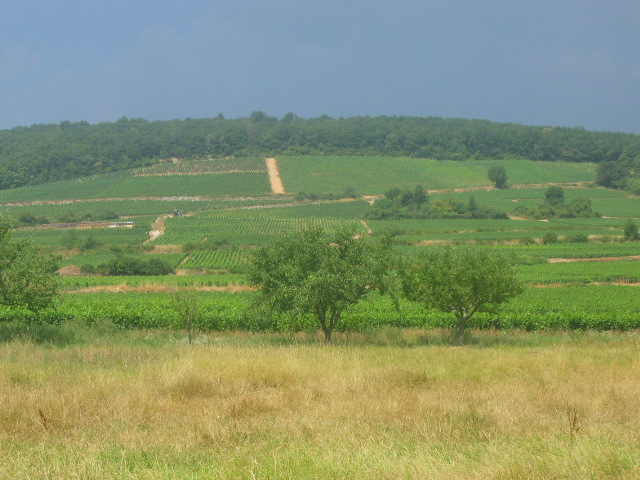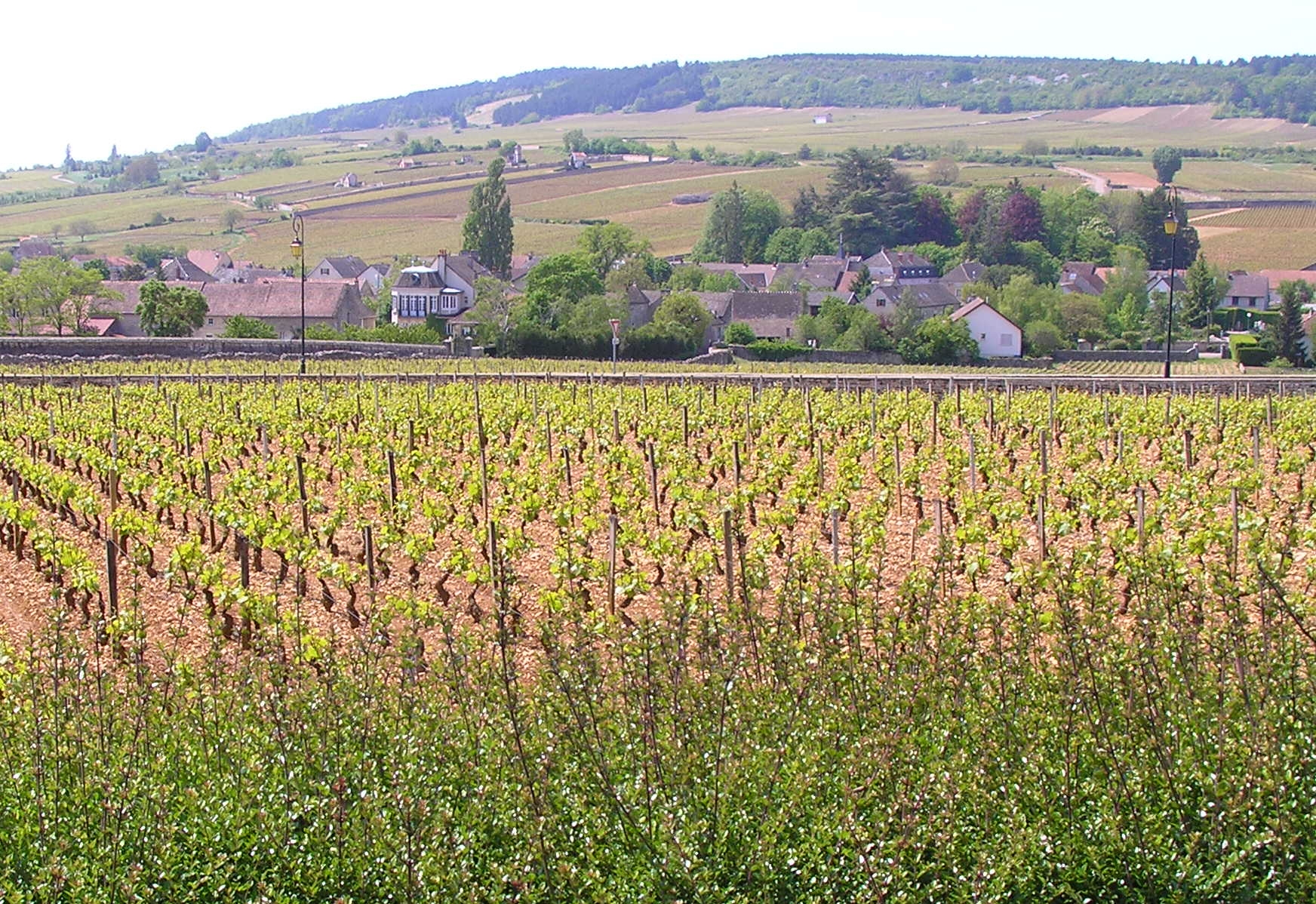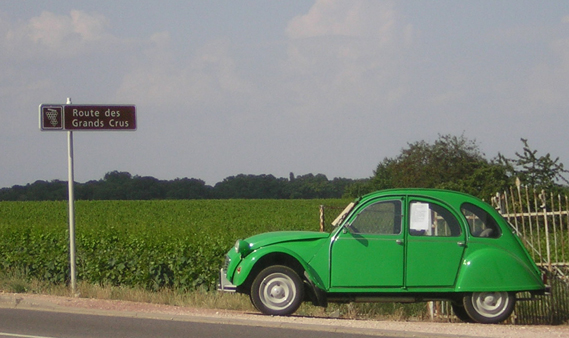Côte d'Or (escarpment) on:
[Wikipedia]
[Google]
[Amazon]


 The Côte d'Or is a
The Côte d'Or is a


 The Côte d'Or is a
The Côte d'Or is a limestone
Limestone ( calcium carbonate ) is a type of carbonate sedimentary rock which is the main source of the material lime. It is composed mostly of the minerals calcite and aragonite, which are different crystal forms of . Limestone forms whe ...
escarpment
An escarpment is a steep slope or long cliff that forms as a result of faulting or erosion and separates two relatively level areas having different elevations.
The terms ''scarp'' and ''scarp face'' are often used interchangeably with ''esca ...
in Burgundy, France of the same name of the '' department'' which was formed around it. It stretches from Dijon
Dijon (, , ) (dated)
* it, Digione
* la, Diviō or
* lmo, Digion is the prefecture of the Côte-d'Or department and of the Bourgogne-Franche-Comté region in northeastern France. the commune had a population of 156,920.
The earlies ...
in the north to the river Dheune to the south, overlooking the valley of the Saône
The Saône ( , ; frp, Sona; lat, Arar) is a river in eastern France. It is a right tributary of the Rhône, rising at Vioménil in the Vosges department and joining the Rhône in Lyon, at the southern end of the Presqu'île.
The name ...
to the east.
The east-facing slope of the Côte d'Or is home to some of the greatest names of Burgundy wine
Burgundy wine ( or ') is made in the Burgundy region of eastern France, in the valleys and slopes west of the Saône, a tributary of the Rhône. The most famous wines produced here, and those commonly referred to as "Burgundies," are dry red win ...
, such as Gevrey-Chambertin, Clos de Vougeot
Clos de Vougeot, also known as Clos Vougeot, is a wall-enclosed vineyard, a ''clos'', in the Burgundy wine region, and an ''Appellation d'origine contrôlée'' (AOC) for red wine from this vineyard. It was named for the River Vouge, which is in ...
, Meursault
Meursault () is a commune in the Côte-d'Or department and region of Bourgogne-Franche-Comté in eastern France.
Etymology
The oldest attested form of the toponym Meursault dates from 1094, as ''Murassalt'' and ''Mussalt'', in a charter by t ...
and Montrachet ''For the restaurant, see Montrachet (restaurant)''
Montrachet (pronounced ''Mon-rashay''; ) is an ''Appellation d'origine contrôlée'' (AOC) and Grand Cru vineyard for white wine made of Chardonnay in the Côte de Beaune subregion of Burgundy. ...
. The northern half, the Côte de Nuits, produces red wine almost exclusively. The Côte de Beaune
The Côte de Beaune area is the southern part of the Côte d'Or, the limestone ridge that is home to the great names of Burgundy wine. The Côte de Beaune starts between Nuits-Saint-Georges and Beaune, and extends southwards for about 25 km ...
, around Beaune
Beaune () is the wine capital of Burgundy in the Côte d'Or department in eastern France. It is located between Lyon and Dijon. Beaune is one of the key wine centers in France, and the center of Burgundy wine production and business. The annua ...
in the south, produces a mix of white wine and red wine. The Route des Grands Crus
The Route des Grands Crus (roughly, "road of the great wines") is the name of a tourist route situated in Burgundy, France.
The approximately 60-kilometre route runs along the foot of the Côte d'Or escarpment, from Dijon in the north to Santen ...
(Route Nationale 74) runs along the foot of the ridge and is popular with tourists.
Scientists have not yet conclusively determined what factors cause the few small parcels of land on the Côte d'Or to produce superlative wines. Hugh Johnson and Jancis Robinson, ''The World Atlas of Wine 7th ed.'' Octopus Publishing Group, 2013 p. 50.
History
The area was settled by the Celts, and there is considerable evidence of Roman occupation in the area. Later it came under the influence of the Dukes of Burgundy, with the Cistercians fromCîteaux Abbey
Cîteaux Abbey (french: Abbaye de Cîteaux, links=no ) is a Catholic abbey located in Saint-Nicolas-lès-Cîteaux, south of Dijon, France. It is notable for being the original house of the Cistercian order. Today, it belongs to the Trappists ...
playing a prominent role in the development of the vineyards.
Geology
If the Parishydrological
Hydrology () is the scientific study of the movement, distribution, and management of water on Earth and other planets, including the water cycle, water resources, and environmental watershed sustainability. A practitioner of hydrology is calle ...
and geological
Geology () is a branch of natural science concerned with Earth and other astronomical objects, the features or rocks of which it is composed, and the processes by which they change over time. Modern geology significantly overlaps all other E ...
basin is viewed as a saucer with Paris at its centre, the Côte d'Or may be seen as a segment of its south-eastern rim; the counterpart of the chalk
Chalk is a soft, white, porous, sedimentary carbonate rock. It is a form of limestone composed of the mineral calcite and originally formed deep under the sea by the compression of microscopic plankton that had settled to the sea floor. Ch ...
cliffs of the Pays de Caux
The Pays de Caux (, , literally ''Land of Caux'') is an area in Normandy occupying the greater part of the French ''département'' of Seine Maritime in Normandy. It is a chalk plateau to the north of the Seine Estuary and extending to the cliffs o ...
, on the English Channel
The English Channel, "The Sleeve"; nrf, la Maunche, "The Sleeve" (Cotentinais) or ( Jèrriais), (Guernésiais), "The Channel"; br, Mor Breizh, "Sea of Brittany"; cy, Môr Udd, "Lord's Sea"; kw, Mor Bretannek, "British Sea"; nl, Het Kana ...
coast to the north-west. The River Seine
)
, mouth_location = Le Havre/Honfleur
, mouth_coordinates =
, mouth_elevation =
, progression =
, river_system = Seine basin
, basin_size =
, tributaries_left = Yonne, Loing, Eure, Risle
, tributarie ...
rises near the Côte d'Or and enters the sea near the Pays de Caux, having passed through Paris.
The Côte d'Or scarp arises where a broad, relatively shallow graben has formed as a result of an interaction between the forces raising the alpine ridges and the Massif Central
The (; oc, Massís Central, ; literally ''"Central Massif"'') is a highland region in south-central France, consisting of mountains and plateaus. It covers about 15% of mainland France.
Subject to volcanism that has subsided in the last 10,0 ...
. The Jurassic limestone
Limestone ( calcium carbonate ) is a type of carbonate sedimentary rock which is the main source of the material lime. It is composed mostly of the minerals calcite and aragonite, which are different crystal forms of . Limestone forms whe ...
contributes the chemically basic component of the mixture of requirements for a good vineyard, while the scarp provides the drainage and aspect
Aspect or Aspects may refer to:
Entertainment
* ''Aspect magazine'', a biannual DVD magazine showcasing new media art
* Aspect Co., a Japanese video game company
* Aspects (band), a hip hop group from Bristol, England
* ''Aspects'' (Benny Carter ...
.
At the Côte d'Or, the middle and upper Jurassic
The Jurassic ( ) is a geologic period and stratigraphic system that spanned from the end of the Triassic Period million years ago (Mya) to the beginning of the Cretaceous Period, approximately Mya. The Jurassic constitutes the middle period of ...
rocks overlook the Oligocene, Pliocene
The Pliocene ( ; also Pleiocene) is the epoch in the geologic time scale that extends from 5.333 million to 2.58Quaternary rocks of the plain through which the Saône flows southward towards the Mediterranean Sea. The ''côte'' therefore forms part of the watershed between northern and southern Europe. On the far side of the plain rise the Jura Mountains, for which the 
thewinedoctor.com
A great overview of the geography and wines of Burgundy.
The Burgundy Report
Good descriptions of the vineyards and vintages. {{DEFAULTSORT:Cote d'Or (escarpment) Burgundy wine Landforms of Côte-d'Or Wine regions of France Escarpments of Europe
Jurassic period
The Jurassic ( ) is a geologic period and stratigraphic system that spanned from the end of the Triassic Period million years ago (Mya) to the beginning of the Cretaceous Period, approximately Mya. The Jurassic constitutes the middle period of ...
was named.

Comblanchien stone
Near Nuits-Saint-Georges, part of the middle Jurassic limestone has beenmetamorphosed
Metamorphic rocks arise from the transformation of existing rock to new types of rock in a process called metamorphism. The original rock (protolith) is subjected to temperatures greater than and, often, elevated pressure of or more, causi ...
into marble. The metamorphism seems to have arisen from the volcanic disturbances in the already existing ( Variscan) Massif Central, set off by the Alpine orogeny. The Massif Central is represented locally by its northern extension, the Morvan
The Morvan (historically Morvand from the Latin ''Murvinnum'' 590)Pierre-Henri Billy, ''Dictionnaire des noms de lieux de la France'', éditions Errance, 640 pages, 2011 , is a mountainous massif lying just to the west of the Côte d'Or escar ...
, which lies between Nevers
Nevers ( , ; la, Noviodunum, later ''Nevirnum'' and ''Nebirnum'') is the prefecture of the Nièvre department in the Bourgogne-Franche-Comté region in central France. It was the principal city of the former province of Nivernais. It is sou ...
and the Côte d'Or.
There is a famous vein of fine-grained marble called ''Pierre de Comblanchien'' extending from the village of Comblanchien, just south of Nuits-Saint-Georges. The quarries lie in the ''Côte'' north and south of the village, overlooking Route Nationale 74. The stone comes in a variety of shades, from beige to the pink of bindweed (Convolvulus
''Convolvulus'' is a genus of about 200 to 250''Convolvulus''.
Flora of China.
). It is not susceptible to frost damage and is capable of accepting a polish.
Flora of China.
See also
*Burgundy wine
Burgundy wine ( or ') is made in the Burgundy region of eastern France, in the valleys and slopes west of the Saône, a tributary of the Rhône. The most famous wines produced here, and those commonly referred to as "Burgundies," are dry red win ...
*French wine
French wine is produced all throughout France, in quantities between 50 and 60 million hectolitres per year, or 7–8 billion bottles. France is one of the largest wine producers in the world, along with Italian, Spanish, and Amer ...
References
Further reading
* A bit out of date, and doesn't cover all of Burgundy, but is still the definitive guide. An updated version covering the whole region is due in early 2008. * Also in the process of being replaced, in two volumes - the book covering the outlying regions is due in late 2007, the Côte d'Or presumably in late 2008. * Foreword byMichael Broadbent
John Michael Broadbent, MW (2 May 1927 – 17 March 2020) was a British wine critic, writer and auctioneer in a capacity as a Master of Wine. He was an authority on wine tasting and old wines.
Career
Broadbent was born in Yorkshire. He was edu ...
, again a little out of date but good coverage of the top domaines.
* Good inexpensive introduction to the region, and up to date.
* An inexpensive introduction to the Côte d'Or and the most up to date.
External links
thewinedoctor.com
A great overview of the geography and wines of Burgundy.
The Burgundy Report
Good descriptions of the vineyards and vintages. {{DEFAULTSORT:Cote d'Or (escarpment) Burgundy wine Landforms of Côte-d'Or Wine regions of France Escarpments of Europe